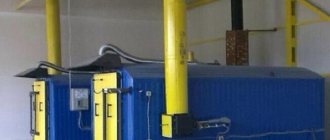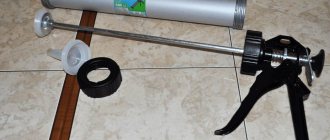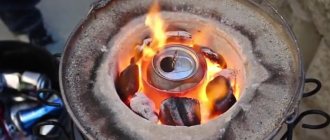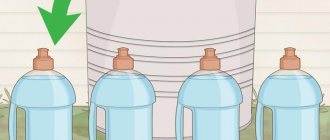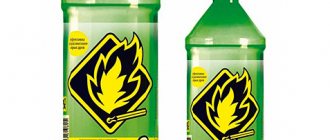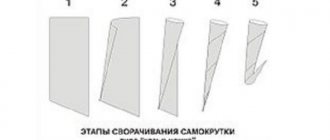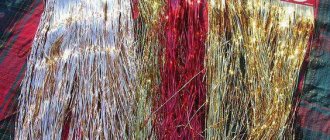Activated carbon tablets
Activated carbon is permeated with micropores and is similar in structure to a sponge that absorbs molecules of organic and inorganic substances. The product is used to treat intoxications, filter liquids and purify air masses, in cosmetology, and in the garden. Activated carbon absorbs substances more strongly than usual.
Why create activated carbon at home?
The need to make activated carbon at home is caused by the wide range of consumption of the product. The traditional method of use is to purify moonshine from fusel fractions. Carbon filler is required in filters for purifying drinking water, water in aquariums, and in home hydroponics.
The air is purified by activated carbon from excess humidity, odors, and pollutants. In the garden, the substance is applied to the ground along with fertilizers and dug into the soil to protect the seedlings. Coal draws excess moisture from the soil and protects the roots of garden crops from rotting and mold development. Cosmetic cleansing of oily skin, masks, gels are another area of application of the absorbent.
The use of a universal absorber in the garden, everyday life, and cosmetology requires large quantities of the drug. Increases consumption and the need for periodic replacement of carbon filler in filters.
Important! Commercial carbon filters contain chemicals that are used to activate carbon masses on an industrial scale. Filters should be used strictly according to the instructions, otherwise the chemicals will add harmful effects to the water being purified.
Directions for use and dosage
The tablets are taken orally with clean drinking water one hour before the intended meal or two hours after the meal. If the patient is forced to take other medications, then charcoal consumption is permissible 1.5-2 hours after taking another drug.
The dosage is calculated based on the patient’s weight, degree of intoxication and age:
- a single dose for adults is 8 tablets (2 g) - for mild symptoms of poisoning, 12 pcs. (3 g) tablets for obvious symptoms of food poisoning.
- a single dose for children is calculated taking into account weight: 1 g of coal per 1 kg of weight - for severe symptoms of increased gas formation or food allergies.
Both adults and children should take charcoal three times a day.
The duration of the course, as a rule, depends on the patient’s symptoms. Usually it does not exceed 3-4 days. For long-term and acute allergic reactions, treatment can last up to 14 days.
Raw materials for making coal
Activated carbon can be prepared from various raw materials: wood, nut shells, animal bones (purchased from slaughterhouses), coal, and oil products.
Charcoal
Coal, which is suitable for further transformation into activated coal, is obtained from trees with dense and non-resinous wood - group A. These are birch, ash, beech (belongs to valuable tree species, not used for producing coal), elm, maple, oak. The use of wood from fruit trees and shrubs is allowed.
The wood is cleared of bark, core, and areas of rot that reduce the density and porosity of the final product. Reduce the yield of the future absorber by increasing the amount of ash.
coconut shell
Whole coconut
Coconut palms are tropical flora. Palm fruits are called nuts because of their hard shell. After extracting the nutritious pulp (juice), the shells are used by local residents to make primitive utensils and in the construction of dwellings.
Excess shells are sold to rope and coal manufacturers. Coconut shells are very dense, so the charcoal is extremely porous. It is considered the best of activated carbons.
Why is it necessary to pre-activate carbon?
At the microscopic level, coal has pores and cracks. Because coal is primarily wood, its pore structure is quite unique. Large cracks are divided into smaller ones, and those in turn are divided into even smaller ones. As a result of this separation, we have many small holes on the surface of the coal. As for fusel oils, on the contrary, their molecules are quite impressive in size. They are perfectly absorbed by coal and settle inside it. At the same time, smaller molecules of ethyl alcohol leave its pores almost unhindered.
Activated carbon differs from simple charcoal in that it has many more branched pores, which were mentioned above. This allows you to significantly increase the absorption capacity of coal. For this reason, if it is possible to use plain charcoal or activated carbon, definitely use the latter.
Manufacturing methods
In industrial production, the drug is obtained by chemical and physical methods. At home, it is realistic to use only the physical method.
Physical method
The physical method includes three stages:
- Obtaining a coal substrate with a low oxygen supply (imitation of industrial pyrolysis).
- Activation of charcoal with water steam.
- Drying.
They take finely chopped wood raw materials (chips of 2–3 cm), without bark, core and without areas of rot.
Wood raw materials are slowly burned. They use a tin can (for example, a coffee can), a cast pan, a frying pan, a fire or a pit.
Operating principle: the container must be closed from above to limit the access of oxygen to the burned raw material. A layer of sand is poured onto the pit or fire. In the tin can, holes are made only at the bottom (to allow flammable gases to escape).
Trees of various species
Coal fuel (for example, for barbecue) is obtained from any trees and shrubs. Firewood with remaining bark, areas of rot, and shavings will be used.
If the goal is to create activated carbon, only hard wood is used as a raw material. The second condition is the absence of resins (in large quantities). Suitable options are beech or oak, but valuable trees are not usually used for charring. The traditional raw material for activated carbon is birch.
Indications
Activated carbon is prescribed for:
- beginning symptoms of intoxication of unknown origin, like a sorbent;
- food poisoning;
- when symptoms characteristic of salmonellosis and dysentery appear;
- drug poisoning (uncontrolled use);
- drug use;
- alcohol intoxication, as a sobering agent;
- hangover syndrome, as a sorbent;
- allergic reactions of food and medicinal origin;
- chronic flatulence;
- preparatory activities for ultrasound examinations of the abdominal cavity;
- diagnosed renal failure;
- jaundice.
Activated carbon cannot be taken as a single drug. It always acts as an addition to prescribed therapy, accelerating the removal of poisons and helping the functioning of the filtering organs.
Algorithm of actions
To obtain a high-quality product, the technological cycle is carefully followed.
Dry distillation of raw materials
Wood raw materials are burned on a gas stove. A fire is used outdoors, and a stove is used in a village house. In a city apartment, a blowtorch will help.
If you can start a fire, the tin can method will do. Dry crushed wood is placed in a tin can, low and wide. Drill several (10–15) holes in the bottom of the jar through which flammable gases and smoke will escape.
The gases will burn in an open flame - the risk of accidental carbon monoxide poisoning is negligible. The top of the tin has no holes. Air does not enter the jar, and the raw materials are charred evenly. When the chips have burned out completely, turn off the heat under the tin and let it cool.
Carbon activation
Hot kettle
The next stage is the activation of the resulting product, or opening of the pores. At home, either steam or immersion in boiling water is used for activation. The latter method washes away the carbon soot - the absorption capacity of the future product is reduced.
More often they use water steam - they hold a coal substrate over it. Take a tall pan, fill it halfway and wait for the water to boil. The semi-finished product is wrapped in gauze and suspended in a pan above the water level - in a cloud of steam. The lid is closed. The steam will expand and unclog the pores of the product.
Drying and storage
The future absorber is wet after activation and needs to be dried. Dry the coal in any available way: in the air, in the oven, in the sun. You can place the already activated gauze product back into tins with holes at the bottom and dry them over a flame. After drying, the drug is ready for use.
If the adsorbent is not used immediately, it is sent for storage. You will need glass jars with tightly sealed lids. Avoid access of air inside, otherwise air pollutants will be absorbed by the porous surface of the coal, and its cleaning power will decrease. The crushed absorbent is poured into the jars and placed in a dark place, as cool as possible: underground, refrigerator. The product lies quietly for several years and does not lose its beneficial properties.
If storage conditions are violated or not created, the drug will lose its absorbency after a few weeks.
Main causes of diarrhea
The cause of diarrhea may be dysbacteriosis.
Most often, diarrhea occurs due to food poisoning. Other common reasons include the following:
- allergy;
- dysbacteriosis;
- avitaminosis.
Diarrhea is often caused by serious chronic diseases. In this case, complex therapy and compliance with all doctor’s recommendations are required. Taking activated carbon is recommended if the cause of indigestion is known.
Particular care must be taken if diarrhea begins in an infant. Young children quickly lose their vital supply of fluid. This leads to dehydration.
Children can be given activated carbon; this natural remedy is usually well tolerated and does not cause unpleasant consequences. Timely release of toxins allows you to quickly cope with diarrhea and normalize stool.
Filter operation
The operating rules for any carbon filter usually prohibit the consumption of the first portion of filtered water. It may contain coal particles, so it is recommended to drain it.
For a homemade filter filled with homemade activated carbon, such a procedure is not necessary: this substance, if it was obtained without the use of any reagents, does not pose a health hazard.
For ease of use, you can embed a tap from a wine package into the storage container.
Air and gas purification
Activated carbons are widely used for air purification. An example is the recovery of solvent vapors through adsorption on active carbon. After saturation of the adsorbent, vapor desorption is carried out, mainly using water vapor at a temperature of 120 - 140 0C. At the final stage of condensation, a mixture of water and solvent is obtained, which can be separated by rectification. Thus, emissions of harmful impurities into the atmosphere are reduced, and valuable substances are returned to the production cycle, which increases the profitability of the technological process. Adsorbing solvent vapors from the air of the working room is necessary for safety reasons in order to reduce explosive concentrations of the vapor-air mixture. Typical solvents that can be recovered on active carbon are diethyl ether, acetone, alcohols, gasoline, toluene, hexane, benzene, fluorinated hydrocarbons, trichloroethane, as well as hydrogen sulfide, etc.
In all cases where it is necessary to remove minor concentrations of highly volatile compounds, as well as compounds with an average boiling point, from the air mixture, it is preferable to use activated carbons with high retention capacity. The retention capacity is based on the high proportion of micro- and submicropores in the carbon sorbent. These sorbents include coals made from coconuts.
The use of active carbons in various fields is not limited to the areas listed above. The unique properties of this amazing material have made it possible to introduce it into many areas: water treatment, gas purification and separation of gaseous media, decolorization and purification of liquids and solutions, use as catalysts and catalyst carriers, metal enrichment, obtaining ultra-low temperatures, high-vacuum technology, use in medicine for treatment of the gastrointestinal tract, blood purification.
World production of active carbons for various fields of human activity is steadily growing every year. Moreover, there is a significant preponderance in favor of coals produced from plant raw materials, usually coconuts. This is due to economic considerations (low cost of obtaining raw materials for the production of the finished product), as well as strict environmental safety requirements.
The source used is a renewable resource and does not contain harmful or toxic impurities. When obtaining raw materials, irreparable harm to the environment is not caused, which is typical when mining hard and brown coals (mining, destruction of fertile soil layer, use of non-renewable resources). When fossil coals are activated at various stages of the technological process, substances that are hazardous to both humans and the environment are released in significant volumes. In addition, activated carbons obtained from coconuts are significantly superior to analogues obtained from fossil coals in many characteristics.
Literature used in the material:
- Water treatment: Handbook. / S.E. Belikova. M.
- Keltsev N.V. Fundamentals of adsorption technology. M.
- Kienle H., Bader E. Activated carbons and their industrial applications.
- Koganovsky A.M., Klimenko N.A., Levchenko T.M., Marutovsky R.M., Roda I.G. Treatment and use of wastewater in industrial water supply. M.
- Kostrikin Yu.M., Meshchersky N.A., Korovina O.V. Water treatment and water regime of low and medium pressure power facilities: Handbook. M.
- Sterman L.S., Pokrovsky V.N., Physical and chemical methods of water treatment at thermal power plants: Textbook for universities. M.
- Frog B.N., Levchenko A.P. Water treatment: Textbook. manual for universities. M.
- “Water purification” No. 8/2010. Publishing House "Panorama"
- “Water Treatment” No. 9/2010. Publishing House "Panorama"
Oligodynamic action of active carbons impregnated with silver
Metals can be arranged in a series of selectivity in accordance with the strength of the oligodynamic effect:
Cadmium > Silver > Copper > Mercury
It has been established that metal cations have a bactericidal effect. Metal ions are adsorbed by the surface of the bacterial cell. The reaction of cations with proteins that make up the cell leads to denaturation of proteins and suppression of the vital activity of the microorganism. This effect is used to prevent contamination of activated carbon by pathogenic microflora, especially in small filters used in everyday life. For the bactericidal effect of active carbon to manifest itself, a sufficiently long contact time of the purified water with the filler is required. The addition of silver does not affect the dechlorination and adsorption capacity of coal.
Benefits of white coal
White charcoal tablets have no taste.
Experts often recommend taking white coal, based on its following benefits:
- greater efficiency (4 g per day is enough);
- provides additional stimulation of intestinal function, as a result there is no need to worry about subsequent constipation;
- the tablets have no taste;
- you can swallow the tablets whole;
- removes excess gases from the intestines, prevents increased gas formation;
- helps normalize the functioning of the digestive system, facilitates the absorption of nutrients;
- reduces the potential for the formation of gallstones.
Methods for regeneration of granular active carbons
The use of significant volumes of active carbon makes the regeneration of the sorbent economically feasible. There are thermal and non-thermal reactivation. During thermal reactivation, spent granular coals are placed in furnaces that are used to produce active carbon (for example, rotary kilns), and are exposed to a gas mixture at high temperatures, about 800 - 900 0C. The disadvantages of this method are the use of complex and bulky equipment and significant losses of coal during firing, on the order of 10–12%.
During non-thermal reactivation, coal is treated with special chemical reagents, usually alkali. The costs of chemical regeneration are comparable to the costs of thermal regeneration, this is primarily due to the fact that the desorbate and chemical reagents must be completely recycled. Some organic compounds are easily decomposed on active carbon by microorganisms (biological regeneration method), but this process proceeds extremely slowly.
Other sorbent options
White charcoal can relieve intestinal gas.
In addition to activated charcoal, there are other types of medications that remove toxins from the body. Among them is white coal.
It is made from silicon dioxide and highly dispersed microcrystalline cellulose. There are also auxiliary substances in the composition, such as potato starch and powdered sugar.
Silicon dioxide is effective in cleansing the body. It is able to remove toxins caused by the activity of microbes or chemicals.
It eliminates allergen substances to which the body reacts acutely. White coal can relieve intestinal gases, products of protein breakdown.
Best answers
CLAYMORE:
To obtain activated carbon, you need to light birch firewood. And then place them in a container and block the access of air to them. After these coals go out and cool, they become suitable for use as a carbon filter. And the black coals of an unburnt fire are not suitable, because they went out on their own with the presence of oxygen in the air and do not have these properties. Good luck
Nastyashka:
take a baton, go with it to the pharmacy, shout that this is a robbery, etc., take coal)))))) and leave
Alexander:
To begin with, birch logs are crushed to a certain size and fired in special ovens without access to air. then unloaded from the oven and cooled. To obtain activated carbon from charcoal, it is necessary to remove the resinous substances. This is achieved by grinding and blowing superheated steam through the charcoal. To remove moisture from the resulting activated carbon, it is dried at a certain temperature. In the production of tablets, coal powder is pressed.
Vadim Startsev:
A variety of firewood is suitable for producing activated carbon, not just birch. I know of an enterprise that produces activated carbon from mostly coniferous fuel. And the coals of an unburnt fire have the properties of an activated one; they are even used as an activated one in camping conditions (and even by some animals in nature for detoxification). To use activated (charcoal) charcoal, you need to heat the plant raw materials without access (or with very limited access) to air and wait until the raw materials are charred. Another thing is that it will be difficult to obtain “first grade” coal in artisanal conditions with undeveloped technology, so at home it is better to use purchased filters, but in nature, in the absence of good water, you can use a firebrand, for lack of a better one.
What will help?
Will Enterosgel (Polymethylsiloxane polyhydrate), which is positioned as a “hangover cure,” help? As in the case of activated carbon, the theoretical basis is present: the gel has a suction surface area that is as much as 10 times larger than activated carbon. The drug obviously will not complicate the work of the endoscopist if it comes to bleeding, and eating half a tube is not like swallowing 200 tablets of charcoal. But let's enable skeptic mode:
- The active substance is not mentioned in any foreign manual. But it is present in the domestic one, adjacent to phospholipids to “protect the liver.”
- Neither the FDA website, nor the Cochrane database, nor Rxlist knows about Polymethylsiloxane.
- In Pubmed, there are exclusively Russian or Ukrainian articles about polymethylsiloxane as a sorbent (and not a substance for chromatography, where it is also used as a gel).
A hangover is caused by changes in the composition of the blood, not the contents of the digestive tract.
Anxiety, headache and other symptoms are a consequence of the accumulation of acetaldehyde (alcohol is converted into it in the liver), acidosis (“acidification” of the body) and dehydration. The conversion of ethanol into toxic acetaldehyde is almost completely (75-98%) carried out in the liver, after which the latter enters the blood. The biochemical processes leading to its accumulation do not depend in any way on the quality of alcohol, but are inevitable consequences of its metabolism. Tying anything in your stomach in the morning is a pointless idea.
How to increase the effectiveness of activated carbon?
It is not difficult to organize the treatment of diarrhea with activated carbon. To increase its effectiveness, it is recommended to follow the following expert advice:
- A couple of tablets can only help a baby. An adult needs to accept almost a whole standard. Generally, it is recommended to take 1 tablet per kilogram of weight.
- A single dose is not enough. After the first dose, you need to wait a few hours and repeat.
- Take the tablets with warm water; you should drink about a glass.
- If diarrhea occurs due to a chronic disease, activated carbon will not stabilize the situation. Complex treatment is required.
- In case of allergic reactions or chemical poisoning, you cannot limit yourself to activated carbon. It is necessary to take other means to eliminate harmful substances from the entire body.
For more information about activated carbon, watch the video:
